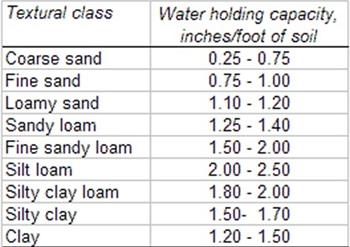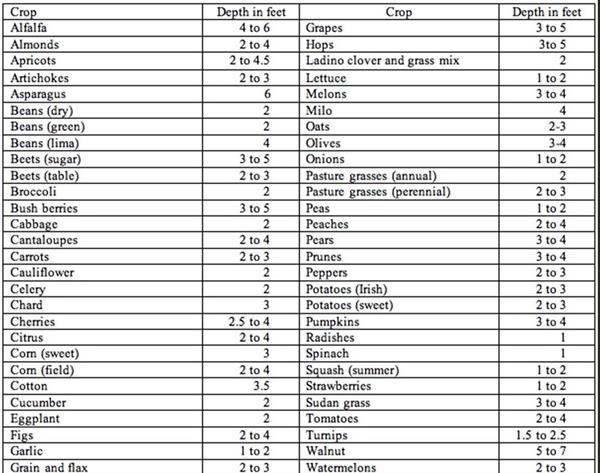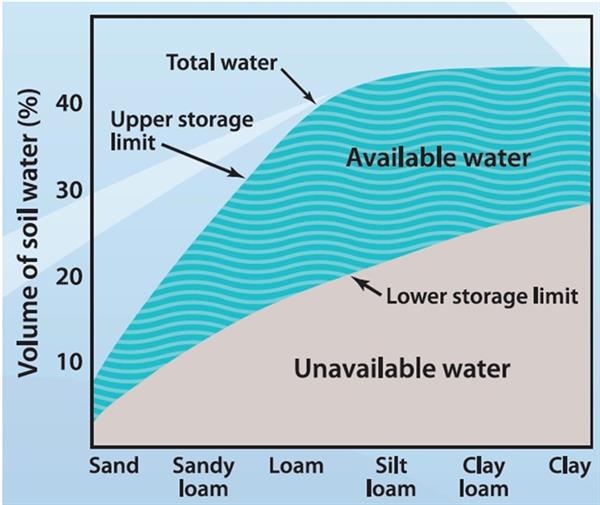
In Arizona agriculture, we have the benefit of generally working with good soils that exist in alluvial valleys or the terraces immediately adjacent to the alluvial valleys, e.g. the mesa areas. Arizona soils are geologically young and fertile but often have high levels of salinity and often sodicity. When reclaimed and properly managed with adequate leaching, we can reduce the salinity to manageable levels to support crop production systems. In the case of sodic conditions, appropriate amendments are needed then followed by adequate leaching.
In the process of applying an irrigation in the field, it is important to recognize that not all soils are created equal. Soil types vary across the landscape and they also vary by depth for any site or location. This is particularly true for alluvial soils which originate from water deposition over time, such as from the Gila and/or Colorado River systems. The soils of the lower Colorado River valleys are great examples of alluvial soils and the high degree of variability we commonly experience in the field. With some crops, particularly more deeply rooted crops, we can sometimes nearly map the soil types across a field based on crop growth patterns. Accordingly, this type of soil variability creates some challenges for in-field management, including irrigation management.
Many of the rotation crops common to the lower Colorado River Valleys, such as cotton, wheat, and sudan; are excellent examples of crops that can express growth patterns as a function of soil texture, which is clearly demonstrated in response to water stress. The courser textured parts of the field will stress earlier and consistently have reduced plant vigor. Anyone driving a tractor for medium to heavy tillage operations in the field will literally feel soil textural changes and anyone harvesting those fields will see it as well. The GPS field mapping systems can detect and record these areas of soil type differences through yield monitors as well in response to crop growth and vigor.
Soil textures vary in terms of water holding capacities and it is important to understand the dominant soil textures in the field, not only on the surface but also through the depths of the soil profile and the effective rooting depth of the crop, Tables 1 & 2 and Figure 1. To manage a complete field or set of fields, it is necessary to determine a functional “average” of soil texture and water holding capacity.
In the process of irrigation, we are attempting to replenish the soil-water extracted by the crop through evapotranspiration (ETc). In previous articles, the determination or estimation of crop ETc has been discussed.
Therefore, with irrigation management it is important to know the fields we are working with in terms of the dominant soil textures present, the degree of variability that exists, and the general water-holding capacity of the soils. Matching irrigation timing and volumes for each event to replenish the plant-available water for each field is important in our efforts to avoid water stress and achieve and maintain irrigation efficiency agronomically, which is providing the amount of water necessary to replenish the soil-water to field capacity with some degree of additional water needed for the leaching of soluble salts.
With the high degree of variability that is common among soils in the lower Colorado River Valleys, it is both important and challenging to know the soil characteristics common in each field, the water holding capacity of the dominant soils, and the level of soil-water depletion that is being replenished with each irrigation event.

Table 1. Soil texture and water holding capacity.

Table 2. Depths to which the roots of mature crops will deplete the available water supply when grown in a deep permeable, well-drained soil under average conditions. Source: Chapter 11, "Sprinkler Irrigation," Section 15, Natural Resources Conservation Service National Engineering Handbook

Figure 1. Soil volume, soil texture, and water holding capacity relationships.
Engineering Handbook.
I am seeking samples of downy mildew on lettuce from around Yuma County to support the Michelmore Lab and their ongoing efforts to help characterize the downy mildew populations of the United States. The Michelmore Lab has led the charge on a survey of Bremia variants since 1980 and has been instrumental in demystifying the gene-for-gene nature of lettuce resistance to downy mildew.
Their group invites growers across the United States to submit downy mildew infected plant samples, which are then used to culture the Bremia on live host plants. The team then inoculates a panel of lettuce varieties carrying known resistance genes to determine the race of each isolate they receive. Identifying which races occur in which specific fields is essential to guiding the breeding of new resistant cultivars and maximizing the effectiveness of host-based genetic disease management. The data obtained from these tests are also used to designate new Bremia races through the International Bremia Evaluation Board.
Your contribution will help breed better lettuce for Yuma. This means less breakdown of resistance in the field, and better yields for Yuma growers. To facilitate these submissions the Yuma Plant Health Clinic will be setting up a separate drop-off point and submission sheet for downy mildew sample submissions in the same hallway we use for standard plant diagnostic submissions. The drop-off point will be clearly labelled and consist of a chest-style refrigerator and printed copies of the submission form. It is vital to keep these samples cool so they remain viable for future inoculations, so please place your samples inside of the refrigerator before you leave.
Shipping will be handled by the clinic. All we ask is that you fill out the submission form as completely as you can. An example of the questions that are asked in that form so you can prepare ahead of time can be found HERE .Plans are firming up for the 2nd Automated Weeding Technologies Field Demo Day. We have penciled in an event date of Thursday, October 21st. The focus this year will be on the latest automated weeding technologies that are “new” since our 2018 event. I’ve been reaching out to multiple companies but am sure I’m not aware of all the cutting-edge technologies out there. We would love to showcase as many innovations as possible, so please contact me if you are interested in demoing your equipment or know someone that is. It’s an open invitation - private companies, and university and government researchers are all welcome!

Malva (malva parviflora) is one of the oldest and most pervasive weeds that that we deal with here. It is also known as little mallow or cheeseweed and is in the same family as cotton, okra and hibiscus. It is often classified as a winter annual but survives all year in this region. It has a deep taproot and can grow in compacted clay or sand and in freezing conditions and high temperatures It provides a refuge for insects and diseases that can damage several crops.
Malva is easy to identify both as a seedling and mature plant. The seedlings are distinctively heart shaped and the mature plant is broad and palm shaped. It is very vegetative and can grow to 6 ft.
The deep tap root of this weed makes it difficult to cut out after it is established. Its response to herbicides id somewhat unusual. It is very sensitive to contact herbicides that do not move into the plant. These include Goal, Sharpen Gramoxone , Rely,Aim and others. However, it is not sensitive to systemic herbicides like 2,4-D and Glyphosate. It reproduces from seed and can be controlled preemergence with many of the same preemergence herbicides used in cotton like Prowl or Treflan. The seed pods are wheel shaped which is where the name cheeseweed comes from. Each seed pod contains 10 to 12 seeds
